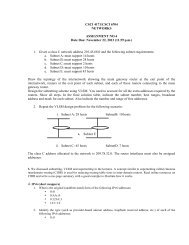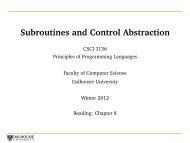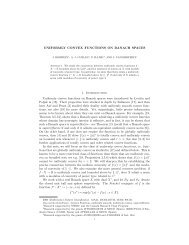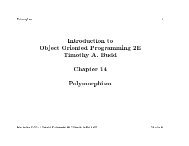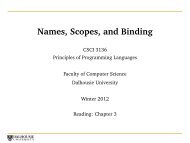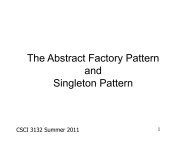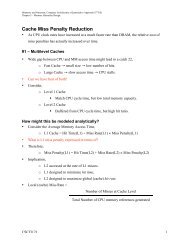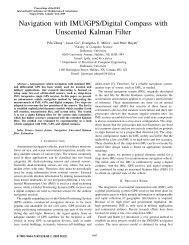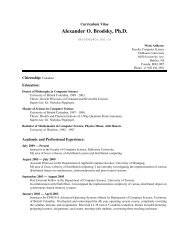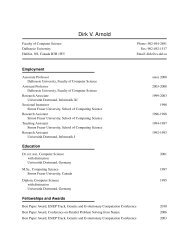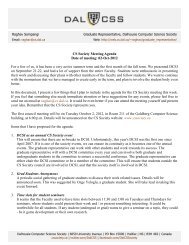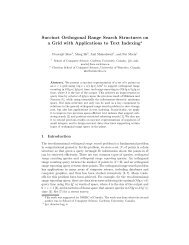Scalable 2d Convex Hull and Trianglulation Algorithms for Coarse ...
Scalable 2d Convex Hull and Trianglulation Algorithms for Coarse ...
Scalable 2d Convex Hull and Trianglulation Algorithms for Coarse ...
You also want an ePaper? Increase the reach of your titles
YUMPU automatically turns print PDFs into web optimized ePapers that Google loves.
<strong>Scalable</strong> <strong>2d</strong> <strong>Convex</strong> <strong>Hull</strong> <strong>and</strong> <strong>Trianglulation</strong> <strong>Algorithms</strong> <strong>for</strong> <strong>Coarse</strong><br />
Grained Mult ieomput ers<br />
Afonso Ferreira* Andrew Rau-Chaplint Stkphane Ukdat<br />
LIP ENS-Lyon Technical University of Nova Scotia LIP ENS-Lyo11<br />
46, allke d’Italie P.O. Box 1000, 46, all& d’Italie<br />
69364 Lyon Cedex 7 Halifax, Nova Scotia 69364 Lyon Cedex<br />
France Canada B3J 2x4 France<br />
Absract<br />
In this paper we describe scalable parallel algorithms<br />
<strong>for</strong> building the <strong>Convex</strong> <strong>Hull</strong> <strong>and</strong> a Triangulation of<br />
a given point set in R2. Theae algorithms are designed<br />
<strong>for</strong> the coarse rained multicomputer model:<br />
p processors with O(gf >> O(1) local memory each,<br />
connected to som,e arbitrary interconnection network<br />
(e.g. mesh,, hypercube, omega). They require time<br />
O( Tseqyntiai + T,(n,p)), where Ts(n,p) refers to the<br />
time of a global sort of n data on a p processor machine.<br />
Furthermore, they involve only a constant number<br />
of global communication rounds. Since computing<br />
either <strong>2d</strong> <strong>Convex</strong> <strong>Hull</strong> or Trian!gulation requires time<br />
Tsequential = @(TI log n) these algorithms either run in<br />
optimal time, e(?), or in sort time, ~.(n,p), <strong>for</strong><br />
the interconnection network in question. These results<br />
become optimal when T8e9yntiai. dominates T, (n, p),<br />
<strong>for</strong> instance when r<strong>and</strong>omized sorting algorithms are<br />
used, or <strong>for</strong> interconnection networks like the mesh <strong>for</strong><br />
which optimal sorting algorithms exist.<br />
1 Introduction<br />
Most existing multicomputers (e.g. the Intel<br />
Paragon, Cray T3D, Meiko CS-:2 <strong>and</strong> IBM SP2) consist<br />
of a set of p state-of-the-art processors, each with<br />
considerable local memory, connected to some interconnection<br />
network (e.g. mesh, hypercube, omega).<br />
These machines are usually coarse grained, i.e. the<br />
size of each local memory is “considerably larger” than<br />
O(1). Despite this fact, most theoretical parallel algorithms,<br />
in particular those <strong>for</strong> solving geometric problems,<br />
assume a fine grained setting, where a problem<br />
of size n is to be solved on a parallel computer with p<br />
processors (e.g., a PRAM, mesh, or hypercube multiprocessor)<br />
such that 2 = O(1). However, as noted in<br />
* (ferreira@lip.ens-lyon.fr) Partially supported by the project<br />
Stratageme of the French CNRS <strong>and</strong> by DRET<br />
t (arc@tuns.ca) Partially supported by DIMACS, a National<br />
Science Foundation center (USA), <strong>and</strong> the Natural Sciences <strong>and</strong><br />
Engineering Research Council (Canac a).<br />
* (ubeda@lip.ens-lyon.fr) Partially supported by the project<br />
PRS (CAPA) of the French CNRS<br />
[9], to be relevant in practice such algorithms must be<br />
scalable, that is, they must be applicable <strong>and</strong> efficient<br />
<strong>for</strong> a wide range of ratios E.<br />
P<br />
In this paper we describe scalable parallel algorithms<br />
<strong>for</strong> some fundamental geometric problems.<br />
Among the first scalable coarse grained algorithms<br />
<strong>for</strong> solving geometric problems on distributed memory<br />
machines were described in [6]. The majority of these<br />
algorithms were optimal on architectures <strong>for</strong> which<br />
optimal sorting algorithms were known <strong>and</strong> reciuired<br />
at most sort time otherwise. Another important feature<br />
of these algorithms was that they involved only<br />
a constant number of global communication rounds,<br />
which had the effect of malting them very fast in<br />
practice. Problems studied in [6] included computing<br />
the area of the union of rectangles, 3D-maxima, 2Dnearest<br />
neighbors of a point set, <strong>and</strong> lower envelope<br />
of non-intersecting line segments in the plane. All of<br />
these algorithms used. a spatial partioning technique<br />
in which a constant number of partitioning schemes<br />
of the global problem (on the entire data set of 12<br />
data items) into p subproblems of size O( %) were used.<br />
Each processor solved (sequentially) a constant number<br />
of such O($) size subproblems, <strong>and</strong> a const>ant<br />
number of global routing operations were used to permute<br />
the subproblems between the processors. Eventually,<br />
by combining the O(1) solutions of its O($)<br />
size subproblems, each processor determined its O( $)<br />
size portion of the global solution.<br />
For most of the problems addressed in [6] the spatial<br />
partitioning technique described above were very<br />
efficient. One exception was the <strong>2d</strong> <strong>Convex</strong> <strong>Hull</strong><br />
problem <strong>for</strong> which the resulting algorithm required<br />
+ Ts(n,p) + logpTs(p,p)) time <strong>and</strong> involved<br />
O ( y<br />
logp global communication rounds. Subsequent work<br />
on this problem has focussed on developing r<strong>and</strong>oniized<br />
algorithms that trade-off guaranteed solutions <strong>for</strong><br />
efficiency (i.e. a constant number of commnnication<br />
rounds). In [7] Deng <strong>and</strong> Gu solve the <strong>2d</strong> convex h~dl<br />
problem with high probability <strong>for</strong> any input assuming<br />
E > p2+€ while Dehne, Kenyon <strong>and</strong> Fabri solve <strong>for</strong> a<br />
p. -<br />
given a set of “well distributed inputs” the lid convex<br />
1063-6374195 $04.00 0 1995 IEEE<br />
561
hull problem, <strong>for</strong> any constant L, <strong>and</strong> 2 p‘.<br />
In this paper we describe a deterministic scalable<br />
algorithm <strong>for</strong> solving the <strong>2d</strong> convex hull problem on<br />
the coarse grained multicomputer model: p processors<br />
with O(n) >> O(1) local memory each, connected to<br />
P<br />
some arbitrary interconnection network. Our algorithmrequires<br />
time O(F+T,(n,p)), whereT,(n,p)<br />
refers to the time of a global sort of n data on a p processor<br />
machine. Furthermore, it involves only a constant<br />
number of global communication rounds. Based<br />
on this algorithm we also give an algorithm <strong>for</strong> solving<br />
the triangulation problem <strong>for</strong> points in R2 <strong>for</strong> the<br />
same model <strong>and</strong> in the same space <strong>and</strong> time.<br />
Since computing either <strong>2d</strong> convex hull or triangulation<br />
requires time Tseguential = O(n log n) [14]<br />
our algorithms either run in optimal time e(*)<br />
or in sort time T,(n,p) <strong>for</strong> the interconnection net-<br />
work in question. Our results become optimal when<br />
T3 e *” e n t I a I<br />
dominates T,(n,p), <strong>for</strong> instance when ran-<br />
P<br />
domized sorting algorithms are used, or when T,(n,p)<br />
is optimal.<br />
Consider, <strong>for</strong> example, the mesh architecture. For<br />
the fine grained case (; = O(l)), a time complexity of<br />
O( fi) is optimal. Hence, simulating the existing fine<br />
grained results on a coarse grained machine via Brent’s<br />
Theorem [ll] leads to a O($& time coarse grained<br />
method. Our algorithmruns in time O(:(logn+fi)),<br />
a considerable improvement over both simulation <strong>and</strong><br />
the existing methods.<br />
The <strong>Coarse</strong> Grained Multicom uter model, or<br />
CGM(n,p) <strong>for</strong> short, is defined in b]. It consists of<br />
a set of p processors with O($) local memory each,<br />
connected to some arbitrary interconnection network<br />
or a shared memory. The term “course graine8’ refers<br />
to the fact that (as in practice) the number of words<br />
of each local memory O(;) is defined to be “considerably<br />
larger” than O(1). Our definition of “considerably<br />
larger” (<strong>and</strong> the one used in [SI) is that : 2 p.<br />
This is clearly true <strong>for</strong> all currently available coarse<br />
grained parallel machines. In the following, all messages<br />
are composed of a constant number of words<br />
<strong>and</strong>, <strong>for</strong> determining time complexities, we will consider<br />
both local computation time <strong>and</strong> inter processor<br />
communication time in the st<strong>and</strong>ard way.<br />
For the problems studied in this paper, we are interested<br />
in algorithms which are optimal or at least<br />
efficient <strong>for</strong> a wide range of ratios 2. We present a<br />
new technique <strong>for</strong> designing efficient scalable parallel<br />
geometric algorithms. Our results are independent of<br />
the communication network (e.g. mesh, hypercube, fat<br />
tree). A particular strength of this approach (which<br />
is very different from the one presented in [l, SI), is<br />
that all inter processor communication is restricted to<br />
a constant number of usages of a small set of simple<br />
communication operations. This has the effect of making<br />
the algorithms both easy to implement in that all<br />
communications is per<strong>for</strong>med by calls to a st<strong>and</strong>ard<br />
highly optimized communication library <strong>and</strong> very fast<br />
P<br />
in practice (see [6] <strong>for</strong> evidence of this).<br />
Our <strong>Convex</strong> <strong>Hull</strong> algorithm is described below <strong>and</strong><br />
has the following basic structure. The entire data set<br />
<strong>for</strong> a given problem is assumed to be initially distributed<br />
into the local memories <strong>and</strong> remains there<br />
until the problem is solved. Given a set S of n points<br />
<strong>and</strong> a p processor coarse grained multicomputer we<br />
show how to compute the upper hull of S. The lower<br />
hull, <strong>and</strong> there<strong>for</strong>e the complete hull, can be computed<br />
analogously. In the remainder we assume without loss<br />
of generality that all points are in the first quadrant.<br />
Upper <strong>Hull</strong>(S)<br />
[nput: Each processor stores a set of points drawn arbixarily<br />
from S.<br />
Dutput: A distributed representation of upper hull of S. All<br />
Joints on the upper hull are identified <strong>and</strong> labeled from left<br />
.o right.<br />
1. Globally sort the points in S by x-coordinate. Let S, denote<br />
the set of 2 sorted points now stored on processor<br />
2.<br />
2. Independently <strong>and</strong> in parallel, each processor i computes<br />
the upper hull of the set S;. Let X ; denote the result on<br />
processor i.<br />
3. By means of a merge operation compute <strong>for</strong> each upper<br />
hull X;, 1 < i 5 p, the upper common tangent line between<br />
it <strong>and</strong> all upper hulls X, , i < j < p, <strong>and</strong> label the<br />
upper hull of S by using the upper tangent lines.<br />
Step 1 of algorithm Upper<strong>Hull</strong>(S) can be completed<br />
by using a global sort operation as described in Section<br />
2. Step 2 is a totally sequential step <strong>and</strong> can be<br />
completed in time O( F) using well known sequential<br />
methods [14]. The main challenge is in per<strong>for</strong>ming<br />
Step 3. This step amounts to a merge algorithm<br />
in which p disjoint upper hulls are merged into a single<br />
hull. We present two different merge procedures:<br />
Merge<strong>Hull</strong>sl <strong>and</strong> Merge<strong>Hull</strong>s2. The first, described<br />
in Section 3.3, is a straight<strong>for</strong>ward merge requiring a<br />
constant number of global communication rounds <strong>and</strong><br />
11 > p2 local memory per processor. The second merge<br />
P -<br />
procedure (Merge<strong>Hull</strong>s2), described in Section 3.4, is<br />
a more complex merge that uses the first merge as<br />
a subprocedure but has a higher degree of scalability<br />
in that it requires only that 3 > p while still requir-<br />
P -<br />
ing only a constant number of communication rounds.<br />
Both algorithms use the idea of selecting splitter sets<br />
which was introduced in the context of solving convex<br />
hulls by Miller <strong>and</strong> Stout [13].<br />
Our algorithm <strong>for</strong> triangulating n points in R2 is<br />
based on our convex hull algorithm <strong>and</strong> the observation<br />
that a set S of points can be triangulated by first<br />
triangulating x-disjoint subsets from S <strong>and</strong> then triangulating<br />
the regions between the convex hulls <strong>for</strong>med<br />
by these triangulated regions, which is a simpler subproblem<br />
as these regions belong to a class of simple<br />
562
polygons called funnel polygons [ 161.<br />
The remainder of this paper is organized as follows:<br />
in the next section we give more details about<br />
the coarse grained multicomputer model, CGM(n, p).<br />
Section 3 presents our Upper <strong>Hull</strong> algorithm, whi e<br />
Section 4 describes how the Upper <strong>Hull</strong> algorithm can<br />
be adapted to solve the triangulaiion problem. In section<br />
5 we conclude.<br />
2 The <strong>Coarse</strong> Grained Model: Definitions<br />
<strong>and</strong> Basic Operations<br />
The <strong>Coarse</strong> Grazned Multzcomputer, CGM(n,p),<br />
considered in this paper is a set (of p processors numbered<br />
from 1 to p with O(%) local memory each, connected<br />
via some arbitrary interconnection network or<br />
a shared memory. Commonly used interconnection<br />
networks <strong>for</strong> a CGM include the 2D-mesh e.g. Intel<br />
Paragon), hypercube (e.g. Intel iPSC/S60\ <strong>and</strong> the<br />
fat tree (e.g. Thinking Machine,; CM-5). For determining<br />
time complexities, we limit all messages to a<br />
constant number of words <strong>and</strong> account <strong>for</strong> both local<br />
computation time <strong>and</strong> inter processor communication<br />
time. The term “coarse grained” refers to the fact<br />
that the size O(:) of each local memory will typically<br />
be “considerably larger” than 0 (1). We will assume<br />
either > p as was assumed in [6].<br />
P -<br />
Global sort refers to the operation of sorting O(n)<br />
data items stored on a CGM(n,p), O(f) data items<br />
per processor, with respect to the CGiWs processor<br />
numbering. T,(n,p) refers to the time complexity of<br />
a global sort.<br />
Note that, <strong>for</strong> a mesh T,(n,p) = O($(logn + Jis))<br />
<strong>and</strong> <strong>for</strong> a hypercube T,(n,p) = O(:(logn<br />
+ log’p)).<br />
These time complexities are based on [2] <strong>and</strong> [12], respectively.<br />
Note that <strong>for</strong> the h,ypercube an asymptotically<br />
better deterministic algorithm exists [4], but<br />
it is of more theorical than practical interest. One<br />
could also use r<strong>and</strong>omized sorting [15], but in this paper<br />
we will focus primarily on deterministic methods.<br />
We refer the reader to [2, 3, 10, 3 1, 12, 151 <strong>for</strong> a more<br />
detailed discussion of the different architectures <strong>and</strong><br />
routing algorithms.<br />
We will now outline four other operations <strong>for</strong> interprocessor<br />
communication which will be used in the<br />
remainder of this paper. All of these operations can<br />
be implemented as a constant number of global sort<br />
operations <strong>and</strong> O(:) time local computation. Note<br />
that, <strong>for</strong> most interconnection networks it would be<br />
better in practice to implement these operations directly<br />
rather than using global sort as this would typically<br />
improve the constants in the time complexity of<br />
the algorithms described in the remainder.<br />
Segmented broadcast: In a segmented broadcast operation,<br />
q < p processors with numbers j, < j~ <<br />
... < j, are selected. Each such processor, p,, , broad-<br />
casts a list of 1 5 k < :<br />
data items from its local<br />
memory to the processors p3,+1 . ..p3,+,-1. The time<br />
<strong>for</strong> a segmented broadcast operation will be referred<br />
to 8s T.b(k,p)-<br />
Segmented gather: In a segmented gather operation,<br />
q 5 p processors with ids j, < j2 < . . . < j, are<br />
selected. Each such processor, pj;, is sent a data item<br />
from processorspj,+l . . . pj,,, -1. This operation is the<br />
inverse of a segmented broadcast. Note that care must<br />
be taken to ensure that the selected processors have<br />
enough memory to receive all sent messages. The time<br />
<strong>for</strong> a se mented gather operation will be referred to as<br />
TS,(k,P5.<br />
All-to-All broadcast: In an All-to-All broadcast operation,<br />
every processor sends one message to all other<br />
processors. The time complexity will be denoted as<br />
Ta2a (P).<br />
Personalized All-to-.All broadcast: In a Personalized<br />
All-to-All broadcast operation, every processor sends<br />
a different message to every other processor. The time<br />
complexity will be denoted as Tpa2a(n,p).<br />
Partial sum (Scan): Every processor stores one<br />
value, <strong>and</strong> all processors compute the partial sums of<br />
these values with respect to some associative operator.<br />
The time complexity will be denoted as Tps(n,p).<br />
For any CGM(n,p) with 2 p it is easy to show<br />
that these operations are no more complex than sorting<br />
plus a linear arnount of sequential work [6], i.e.,<br />
they require O(f + T,(n,p)).<br />
3 Merging <strong>Convex</strong> <strong>Hull</strong>s in Parallel<br />
In this section we show how to complete the upper<br />
hull algorithm given in Section 1 by merging p<br />
x-disjoint upper hulls stored on a p-processor CMG,<br />
one per processor, into a single upper hull.<br />
We denote by % the line segment connecting the<br />
points a <strong>and</strong> b <strong>and</strong> by (ab) the line passing through U<br />
<strong>and</strong> b. A point c is said to be dominated by the line<br />
segment a if <strong>and</strong> only if c’s x-coordinate is strictly<br />
between the x-coordinates of a <strong>and</strong> b, <strong>and</strong> c is located<br />
below the line segment ab. Definitions 1 <strong>and</strong> 2, as<br />
illustrated by Figure 1, establish the initial condition<br />
be<strong>for</strong>e the merge step.<br />
Definition 1 Let {Si), 1 5 i 5 p be a partition of S<br />
such that Vx E Sj, y E Si, j > i, the x-coordinate of<br />
x is larger than that of y (see Figure 1).<br />
Definition 2 Let Xi = (z1, x2,. .., x,} be an upper<br />
hull. Then, predx, (xi) denotes xi-1 <strong>and</strong> SUCX, (xi)<br />
denotes the point xi+l (see Figure 2).<br />
Given two upper hulls UH(Si) <strong>and</strong> UH(Sj) where<br />
all points in Sj are to the right of all points in Si, the<br />
merge operations described in this paper are based on<br />
computing <strong>for</strong> a point q E Xi the point p E Xi U<br />
Xj which follows q in UH(Si U Sj). The following<br />
definitions make this idea more precise (See Figure 2).<br />
Definition 3 Let Q C s. Then, NextQ : S -+ Q as<br />
a function such that NextQ(p) = q if <strong>and</strong> only if q is<br />
to the right of p <strong>and</strong> is above pq’ <strong>for</strong> all q‘ E S, q’<br />
to the rzght of p.<br />
563
o... ........................<br />
C<br />
...................<br />
line(c3<br />
Figure 1: In this example S = {SI, S2,S3, S4) <strong>and</strong> the<br />
points in Si that are filled in are the elements of the<br />
upper hull of Si, namely Xi.<br />
Definition 4 Let Y S,. Then, lm(Y) zs a function<br />
such that lm(Y) = y* zf <strong>and</strong> only zf y- zs the leftmost<br />
potnt tn Y such that Nextyus,,3>t(yv) @ St).<br />
Figure 3: One step in the binary search procedure<br />
QueryFindNext. Since the line segment .cqsue(z4)<br />
is above the line (ezq) the algorithm will recurse on<br />
(24.. .. , x8).<br />
XX<br />
hull of a point set S located in the first quadrant if <strong>and</strong><br />
only if all the n- 2 remaining points fall below the line<br />
(a,b)”. We will work with a new characterization of<br />
the upper hull of S based on the same observation,<br />
but defined in terms of the partitioning of S given in<br />
Definitions 1 <strong>and</strong> 4.<br />
Consider sets S, Si <strong>and</strong> Xi as given in Definitions 1<br />
<strong>and</strong> 2.<br />
Definition 5 Let S’ = {e E U Xi 1 c is not dominated<br />
by a line segment zlNeztUxj,j,i(z;),l 5 i < p},<br />
where x; = lm(X,).<br />
We then have the following characterization of<br />
CH(S).<br />
Let X represent the upper hull of a set of n points.<br />
Let also c be a point located to the left of this<br />
set. Below, we present a sequential algorithm called<br />
QueryFindNext to search <strong>for</strong> q = Neztx(c). Figure<br />
3 illustrates one step of this algorithm. This binary<br />
search process takes time O(1og 1x1).<br />
Procedure QueryFindNext (X,c,q)<br />
[nput: an upper hull X = {XI,.<br />
Zoordinate <strong>and</strong> a point c to the left of 21.<br />
Output: a point q E X, q = NeztX(c).<br />
1. If X = {z} then q t z <strong>and</strong> halt.<br />
... zm} sorted by x-<br />
2. If z,m,21suc(z,m/21) is located below the line<br />
(c~l~,~l) then QueryFindNext((z1.. ... xlm/21},c,q).<br />
else QueryFindNext({zr,/21,. ... zm},c,q).<br />
3.1 Characterization of the upper hull<br />
A classical way of characterizing the upper hull of<br />
a point set S, as given in [14], is based on the observation<br />
that “A line segment ab is an edge of the upper<br />
Theorem 1 S‘ = UH(S)<br />
0<br />
Proof: We must consider two cases.<br />
0 UH(S) c S’<br />
Suppose y E UH(S), y @ SI. Then 3z such<br />
that z:iVextxJ ,3>z(z:) dominates y. There<strong>for</strong>e,<br />
y $ I;H(S), which is a contradiction.<br />
0 SI UH(S)<br />
Suppose y E S’, y @ UH(S). Then 3p,q<br />
withp E UH(S),q E UH(S), <strong>and</strong> q = Nezts(p) ,<br />
such that Pq dominates y.<br />
There<strong>for</strong>e, both q <strong>and</strong> p cannot belong to X,<br />
(since y E X,, meaning that y is not dominated<br />
by any line segment with endpoints in Sz). Thus,<br />
p <strong>and</strong> q belong respectively to X, <strong>and</strong> Xk, (j# IC).<br />
Hence, since q = Nests(p), p E UH(S), <strong>and</strong><br />
q E UH(S), then 3i such that p = r:, where<br />
z: = lm(X,). There<strong>for</strong>e, y is dominated by a<br />
segment x:iVextxl ,3>l(z:), which is a contradiction.<br />
564
3.2 Parallel Merge <strong>Algorithms</strong><br />
In this section we describe twci parallel merge algorithms<br />
based on the characteriza.tion of UH(S) given<br />
in the previous section <strong>and</strong> analyze their time <strong>and</strong><br />
space complexity <strong>for</strong> the coarse grained model. The<br />
following definitions <strong>and</strong> lemma are needed in the description<br />
of the algorithms.<br />
Definition 6 Let Gi<br />
Xi <strong>and</strong> g; = Zm,(Gi). Let<br />
Ri C Xi be composed of the points between predc, (gt)<br />
<strong>and</strong> gt, <strong>and</strong> RF C Xi be compcsed of the points between<br />
g: <strong>and</strong> suc~,(g:) (see Figure 4).<br />
G,. X,. 0<br />
S,<br />
b<br />
---....<br />
Figure 4: Filled points are element of Gi which is a<br />
subset of Xi composed of both of hollow <strong>and</strong> filled<br />
points. Since the Rf doesn't contained any point<br />
above the line (gfb) we have Ri = RF.<br />
We have then the following lemma.<br />
Lemma 1 One or both of RT cr R; is such that all<br />
its points are under the line (gz*lVextx,,j>;(gf)).<br />
The proof of this lemma is direct, otherwise gr $Z<br />
Xi.<br />
Definition 7 Let Ri denote the set R: or Ri that<br />
has at least one point above the line<br />
(gfNeztxj,j>i(g:)) (see Figure ,$).<br />
Note that the size of the sets Ri is bounded by<br />
the number of points laying between two consecutive<br />
points in Gi.<br />
3.3 Merge Algorithm fo.r the Case n/p 2<br />
P2<br />
In this section, we describe an algorithm that<br />
merges p upper hulls, stored one per processor on a p<br />
processor CGM, into a single upper hull using a constant<br />
number of global communication rounds. This<br />
algorithm requires that be greater than or equal to<br />
p2 <strong>and</strong> thus exhibits limited scalability. This limitation<br />
on the algorithms sca1abilit;y will be addressed in<br />
the next section.<br />
In order to find the upper common tangent between<br />
an upper hull Xi <strong>and</strong> an upper hull Xi (to its right)<br />
the algorithm computes the Next function not <strong>for</strong> the<br />
whole set X . but <strong>for</strong> a subset of s equally spaced points<br />
from Xi. de call this subset of equally spaced points a<br />
splitter of Xi. This approach based on splitters greatly<br />
reduces the amount of data that must be communicated<br />
between processors without greatly increasing<br />
the number of global communication rounds that are<br />
required.<br />
4lgorithm Merge<strong>Hull</strong>sl(Xi(1 5 i 5 n),S,n,n,s,UH)<br />
[nput: The set of 7r upper hulls Xi consisting of a total of<br />
tt most n points from S, where Xi is stored on processor q;,<br />
1 5 i 5 K <strong>and</strong> an integer s.<br />
3utput: A distributed representation of the upper hull of S.<br />
211 points on the upper hull are identified <strong>and</strong> labeled from<br />
eft to right.<br />
1. Each processor q; sequentially identifies a splitter set G;<br />
composed of s evenly spaced points from Xi.<br />
2. The processorsfind in parallelgz! = Im(G;). This is done<br />
via a call to Procedure FindLMSubset.<br />
3. Each processor qi computes its own RL <strong>and</strong> R;' sets<br />
according to Definition 6, <strong>and</strong> the set R; of points which<br />
are above the line (g1NeztG;"xj,j>;(gf)), according to<br />
Lemma 1.<br />
4. The processors find in parallel z: = Im(R; U gt), using<br />
Procedure FindLMSubset. Note that by definition<br />
Nexts(zz) @Xi.<br />
5. Each processor qi broadcasts its zf to all q,, j > i, <strong>and</strong><br />
computes its own S:; according to Definition 5. By Theorem<br />
1 this is a distributed representation of UH(S).<br />
Analysis<br />
Steps 2 <strong>and</strong> 4 of the algorithm above are implemented<br />
via the procedure Fin.dLMSubset which is described<br />
in detail the next section. The key idea in procedure<br />
FindLMSubset is to send the elements of G; or Ri, in<br />
Steps 2 <strong>and</strong> 4, respectively, to all larger-numbered processors<br />
so that processors receiving G = U Gj,j < i<br />
(at Step 2) or R = U(Rj Ug;),j < i (at Step 4) can<br />
sequentially compute the required points using Procedure<br />
QueryFindNext described in Section 3. The<br />
algorithm Merge<strong>Hull</strong>sl requires ST space at Step 2,<br />
<strong>and</strong> 5 4 space at Step 4. Thus, if we set<br />
T = s = p, then this algorithm requires n/p 2 p2<br />
space per processor. With respect to time complexity<br />
note that only a constant number of sort <strong>and</strong> comiiiunication<br />
rounds are required, plus sequential computations.<br />
The time required by the algorithm is there<strong>for</strong>e<br />
O(? + T,(n,p)).<br />
3.4 Merge Algorithm <strong>for</strong> the Case ri/p 1 p<br />
In this section, we describe an algorithm, Merge-<br />
<strong>Hull</strong>s2, that merges p upper hulls, stored one per processor<br />
on a p processor CGM, into a single upper<br />
hull using a constant number of global communication<br />
rounds. Unlike the algorithm given in the previous<br />
section this algorithm requires only n/p 2 p memory<br />
space per processor. It is based on algorithm Merge-<br />
<strong>Hull</strong>sl, except that; now two phases are used.<br />
565
1. In the first phase, the algorithm Merge<strong>Hull</strong>sl is<br />
used to find the upper hull of groups of T = &<br />
processors, with s equal to &. Kote that the<br />
space required in this phase is O(p).<br />
2. The second phase merges these fi upper hulls<br />
of size at most each, instead of the p ini-<br />
P<br />
tial ones. Thus, with s = & again, Step 2 requires<br />
only p space. However, we should be careful,<br />
because the size of each set Ri is, in the worst<br />
case, 9, implying that Step 4 requires up to LL<br />
4<br />
space, which is too much. Thus, a further reduction<br />
of their sizes is needed. This is accomplished<br />
through the simple observation that the sets R;<br />
are upper hulls themselves, <strong>and</strong> we can recursively<br />
apply to the Ri, <strong>for</strong> all i, the the same method<br />
udes in Merge<strong>Hull</strong>sl to find xt = Im(Ri U gf).<br />
The algorithm is as follows. When the processors<br />
are divided into groups, let 41 denote the z-th processor<br />
of the i-th group.<br />
Procedure FindLMSubset(X;, IC, w, G;,g%*)<br />
[nput: Upper hulls Xi, 1 5 i 5 IC;, represented each in w<br />
:onsecutively numbered processors qi, 1 5 z 5 w, <strong>and</strong> a set<br />
T; c xi.<br />
Output: The point gt = Im(G;). There will be a copy of gt<br />
n each q:, 1 5 2 5 w.<br />
1. Gather G; in processor q: , <strong>for</strong> all i.<br />
2. Each processor ql sends its G; to all processors q:, j ><br />
Each processor qt, <strong>for</strong> all i,z, receives<br />
i,l 5 z 5 w.<br />
E' = uGj,Vj < i.<br />
3. Each processor q:, <strong>for</strong> all i,z, sequentially computes<br />
Neztx;(g) <strong>for</strong> every g 6 E', using procedure<br />
QueryFindNext.<br />
4. Each processor q;, <strong>for</strong> all i, z, sends back to all processors<br />
qi, j < i, the computed Neztx,(g), Vg E G,. Each processor<br />
qi , <strong>for</strong> all i, receives <strong>for</strong> each g E G; the computed<br />
Nextx, (g), Vj > i.<br />
5. Each processor qi, <strong>for</strong> all i, computes <strong>for</strong> each g E G; the<br />
line segment with the largest slope among gsvcc, (9) <strong>and</strong><br />
gNext,yi (g), j > i, finding NeztGiuxi,,>;(g). Then, it<br />
comput,es gt? = Im(G;).<br />
6. Broadcast g** to q5,l 5 z 5 w.<br />
Input: Upper hulls X;,1 5 i 5 IC; represented each in w<br />
consecutively numbered processors qi, 1 5 z 5 w, <strong>and</strong> a set<br />
G; C Xi.<br />
Output: The point zCf = lm(X;). There will be a copy of zCf<br />
in each qi, 15 z 5 w.<br />
1. FindLMSubset(X;, IC, w, G;,gt).<br />
2. If gisucxi(gz*) is above gfNextXj,,>;(gf) then R; is<br />
composed of all points of Xi between g: <strong>and</strong> sucG;(gf);<br />
else R; is composed of all points of X; between<br />
predc; (gt) <strong>and</strong> gt.<br />
3. Let G; t R; U {gf}.<br />
4. If IG;l *IC 5 p<br />
then FindLMSubset(X,, IC, w, G;, zCf)<br />
else FindLMSub<strong>Hull</strong>(X;, IC, w,G;, z:)<br />
Qlgorithm Merge<strong>Hull</strong>s2(X;(l 5 i 5 r),S,n,r,s,UH)<br />
hput: The set of r upper hulls X; consisting of a total of<br />
tt most n points from S, where X; is stored on processor q;,<br />
I 5 i 5 rr <strong>and</strong> an integer s.<br />
3utput: A distributed representation of the upper hull of S.<br />
411 points on the upper hull are identified <strong>and</strong> labeled from<br />
eft to right.<br />
1. Each processor 9; sequentially identifies a splitter set G;<br />
composed of s evenly spaced points from Xi.<br />
2. Divide the r processors into ,/% groups of fi<br />
processors each. Do in parallel <strong>for</strong> each group:<br />
FindLMSub<strong>Hull</strong>(X; = UH(S;),IC = fi, w = l,G;,z:).<br />
3. Each processor q; broadcasts its 51 to all qj, j > i.<br />
4. Each processor qj computes its own Si according to Definition<br />
5. By Theorem 1 this is a distributed representation<br />
of the upper hull of the points in each of the fi<br />
groups. Let r;, 1 5 i 5 fi, denote such upper hulls.<br />
5. Each processor q; sequentially identifies a splitter set G;<br />
composed of s evenly spaced points from r;.<br />
6. Do in parallel: FindLMSub<strong>Hull</strong>(X; = r;,k = fi,w =<br />
J;;,G,,xf).<br />
i. Each processor 9; broadcasts its x: to all qf, h > i <strong>and</strong><br />
j > 1.<br />
8. Each processor q, computes its own Si according to Definition<br />
5. By Theorem 1 this is a distributed representation<br />
of UH(S).<br />
3.5 Analysis<br />
In the algorithm Merge<strong>Hull</strong>s2, if we let T = p <strong>and</strong><br />
s = fi, then Step 2 requires n/p space, as seen in the<br />
analysis of the algorithm Merge<strong>Hull</strong>sl. Notice that<br />
the space complexity of procedure FindLMSubset is<br />
lGil * IC (at Steps 2 <strong>and</strong> 4). Thus, Step 7's call to<br />
procedure FindLMSubset requires IGi[ * k = p space.<br />
Now, let us analyze the space requirements of Step<br />
7's call to procedure FindLMSub<strong>Hull</strong>. At Step 1 of<br />
FindLMSub<strong>Hull</strong>, the call to procedure FindLMSubset<br />
requires IGil*k = p space. At Step 5, IGil*k is greater<br />
than p implying that a recursive call takes place in<br />
566
order to reduce the size of the considered sets. Both<br />
new calls to FindLMSubset within the recursive call<br />
to FindLMSub<strong>Hull</strong> then require p space. There<strong>for</strong>e,<br />
Step 7 requires nlp 2 p space, <strong>and</strong> this is the space<br />
requirement <strong>for</strong> the Merge<strong>Hull</strong>s2 algorithm as a whole.<br />
With respect to time complexity note that only a<br />
constant number of sort <strong>and</strong> cclmmunication rounds<br />
are required, plus sequential computations. The time<br />
required by the algorithm is there<strong>for</strong>e O ( F<br />
Ts (n, P>>.<br />
4 Triangulation of a Point Set<br />
In this section we describe how the same ideas developed<br />
in the previous section can be used to find<br />
a triangulation of a planar point set. The algorithm<br />
is based on geometric observations originally made b<br />
Wang <strong>and</strong> Tsay <strong>and</strong> used in a PRAM algorithm [16r<br />
We extend their basic technique in order to ensure<br />
that the resulting algorithm is both scalable over a<br />
large range of the ratio n/p, <strong>and</strong> uses only a constant<br />
number of global operations rounds. Note that<br />
the triangulation yielded by the algorithm Triangulate<br />
presented below is not the same as the one obtained<br />
in [16].<br />
A funnel polygon consists of two x-monotone chains<br />
<strong>and</strong> a top <strong>and</strong> a bottom line segment (see Figure 5).<br />
Given p 2-disjoint convex hulls, Xi 15 i 5 p, <strong>and</strong> a set<br />
of upper <strong>and</strong> lower common tangent lines the regions<br />
between the hulls <strong>for</strong>m a set of funnel polygons if the<br />
horizontal extreme points of consecutive upper hulls<br />
Xi are connected (see Figure 6). Funnel polygons can<br />
easily be triangulated as will be shown in the following<br />
algorithm. For details on funnel polygons in the<br />
contex of triangulations, we refer the interested reader<br />
to [16].<br />
I’riangulate (S)<br />
[nput: Each processor stores a set of 2 points drawn arbixarily<br />
from S.<br />
Output: A distributed representation of a triangulation of<br />
S. All segment lines of the triangulation are identified <strong>and</strong><br />
abeled.<br />
1. Globally sort the points in S by x-coordinate. Let S;<br />
denote the set of sorted points now stored on processor<br />
2.<br />
2. Independently <strong>and</strong> in parallel, each processor i computes<br />
the convex hull of the set S,, <strong>and</strong> the triangulation of its<br />
convex hull. Let X ; denote the upper hull of the set Si<br />
on processor i.<br />
3. Label the upper funnel polygons.<br />
4. Identify each point to its upper funnel polygon.<br />
5. Triangulate the upper funnel polygons.<br />
6. Repeat Steps 3-5 <strong>for</strong> the lower funnel polygons.<br />
In Step 1 the points of S are globally sorted. Step<br />
2 starts by connecting the horizontal extreme points<br />
of consecutive upper hulls X; [see Figure 6). Then,<br />
xT = lm(X;) <strong>and</strong> Neztx,,j>i(zT) are computed as<br />
+<br />
I<br />
in Section 3.4. Finally, an all-to-all broadcast is per<strong>for</strong>med<br />
so that each processor i knows 23 = Zm(Xj)<br />
<strong>and</strong> Neztx,,,>j(zj*), -<strong>for</strong> all i 2 j. Clearly, the time<br />
complexity of this Step is dominated by the coniputation<br />
of xi* <strong>and</strong> NezL(z*), that can be implemented<br />
through the procedures hndLMSubset <strong>and</strong> FindLM-<br />
Sub<strong>Hull</strong> described in the Section 3.4.<br />
Steps 3 <strong>and</strong> 4 are locally per<strong>for</strong>med on each processor,<br />
using the in<strong>for</strong>mation received at the end of<br />
Step 2. Note that, each funnel polygon is delimited by<br />
the segment line zfNezt(zf), <strong>and</strong> labeled Fi (see Figure<br />
6). Given that each processor stores a table with<br />
all common tangent lines, they can identify <strong>for</strong> each<br />
point of their hull the funnel polygon they are part of<br />
by a simple sequential. scan of their hull points.<br />
Step 5 is the most technical one. Let a; <strong>and</strong> bj<br />
denote the points in the left <strong>and</strong> right chain of a funnel<br />
polygon, respectively (see Figure 5). Form records<br />
containing, <strong>for</strong> all points a; on the left chain, the slope<br />
from a point ai to its successor ai+l in the chain. Also,<br />
<strong>for</strong>m records containing, <strong>for</strong> all points b on the right<br />
chain, the absolute value of the slope hom bj to its<br />
successor bj+l in the chain. Note that if we sort the<br />
a’s <strong>and</strong> b’s together by first key: funnel polygon label;<br />
second key: slope records; third key: left chain first,<br />
right chain next; then we get a sequence of the <strong>for</strong>m<br />
{- akak+lbhak+2bh+lbh+2bh+3bh+4pk+3 . . .). The<br />
set of line segments tlhat <strong>for</strong>ms a triangulataon of the<br />
funnel polygon can be easily constructed by <strong>for</strong>ming<br />
the set {(b;a .) U (arbs)}, where aj is the first a to the<br />
left of b; <strong>and</strong> b, is the first b to the left of a,.<br />
Figure 5: Two funnel polygons.<br />
In order to implement this step, we need only a<br />
global sort operation on the a’s <strong>and</strong> b’s, followed by<br />
a segmented broadcast, where each a is broadcast to<br />
every element until the next a to its right in the sorted<br />
list, <strong>and</strong> each b is broadcast to every element until the<br />
next b to its righik in the sorted list. The line segments<br />
composing the triangulation can thus be easily<br />
constructed.<br />
Only global sort <strong>and</strong> global communication operations<br />
are used in addition to the call to FindLMSubset<br />
<strong>and</strong> FindLMSubBull. There<strong>for</strong>e, procedure Triangulation<br />
above builds a triangulation of a point set in R2<br />
on a CGM(n,p) in time O ( T + T,(n,p)), where<br />
567
T,(n,p) refers to the time of a global sort of n data<br />
on a p processor machine. Furthermore, it only requires<br />
n/p > p local memory, <strong>and</strong> a constant number<br />
of global communication <strong>and</strong> sort rounds.<br />
I<br />
Figure 6: Note that the region between the hulls<br />
can be seen as a set of funnel polygons (U is<br />
lm(Xl)Ne~:ts(l7n(Xl))).<br />
5 Conclusion<br />
In this paper we described scalable parallel algorithms<br />
<strong>for</strong> building the <strong>Convex</strong> <strong>Hull</strong> <strong>and</strong> a Triangulation<br />
of a planar point set <strong>for</strong> the coarse grained<br />
multicomputer model. Our algorithms require time<br />
O ( T + T,(n,p)), where T,(n,p) refers to the time<br />
of a global sort of n data on a p processor machine.<br />
Furthermore, they involve only a constant number<br />
of global communication rounds, either running in<br />
optimal time e(?) or in sort time ~,(n,p) <strong>for</strong><br />
the interconnection network in question. Our results<br />
become optimal when Tsequ~nt'ai dominates T,(n,p),<br />
<strong>for</strong> instance when r<strong>and</strong>omized sorting algorithms are<br />
used, or when T,(n,p) is optimal. For practical purpose<br />
the restriction that : > p is not onerous, but <strong>for</strong><br />
theoretical pers ective it is interesting to note that<br />
by per<strong>for</strong>ming fog(2le)l (0 < E < 1) phases (rather<br />
than two phases) in procedure Merge<strong>Hull</strong>2 this restriction<br />
can be weakened to p 2 pE (as in [SI) while still<br />
maintaining only a constant number of communication<br />
rounds.<br />
The algorithms proposed in this paper were based<br />
on a variety of techniques arising from more theoretical<br />
models <strong>for</strong> parallel computing, such as the PRAM<br />
<strong>and</strong> the fine-grained hypercube. It would be interesting<br />
to identify those parallel algorithm design techniques<br />
<strong>for</strong> theoretical models that can be extended<br />
to the very practical coarse graaned multzcomputer<br />
model.<br />
References<br />
[l] M. J. Atallah <strong>and</strong> J.-J. Tsay. On the paralleldecomposability<br />
of geometric problems. Proc. 5th<br />
Annu. ACM Sympos. Comput. Geom., pages 104-<br />
113, 1989.<br />
[2] K.E. Batcher. Sorting networks <strong>and</strong> their applications.<br />
Proc. AFIPS Sprmg Joznt Computer Conference,<br />
pages 307-314, 1968.<br />
I<br />
[3] D. P. Bertsekas <strong>and</strong> J. N. Tsitsiklis. Parallel<br />
<strong>and</strong> Distributed Computation,: Numerical Methods.<br />
Prentice Hall, Englewood Cliffs, NJ, 1989.<br />
[4] R. Cypher <strong>and</strong> C. G. Plaxton. Deterministic sorting<br />
in nearly logarithmic time on the hypercube<br />
<strong>and</strong> related computers. ACM Symposium on Theory<br />
of Computing, 193-203. ACM, 1990.<br />
[5] F. Dehne, A. Fabri <strong>and</strong> C. Kenyon <strong>Scalable</strong> <strong>and</strong><br />
archtecture independent parallel geometric algorithms<br />
with high probability optimal time. Proceedings<br />
f o the 6th IEEE SPDP, IEEE Press, 586-<br />
593, 1994.<br />
161 F. Dehne, A. Fabri <strong>and</strong> A. Rau-Chaplin <strong>Scalable</strong><br />
Parallel Geometric <strong>Algorithms</strong> <strong>for</strong> <strong>Coarse</strong> Grained<br />
Multicomputers. AGM Symposium on Gomputational<br />
Geometry, 1993.<br />
[i] Deng <strong>and</strong> Gu Good algorithm design style <strong>for</strong> multiprocessors.<br />
6th IEEE Symposium on Parallel <strong>and</strong><br />
Distributed Processing, 1994.<br />
[8] M.T. Goodrich, J.J. Tsay, D.E. Vengroff, <strong>and</strong><br />
J.S. Vitter. External-memory computational geometry.<br />
Foundations of Computer Science, 1993.<br />
[9] Gr<strong>and</strong> Challenges: High Per<strong>for</strong>mance Computing<br />
<strong>and</strong> Communications. The FY 1992 U.S. Research<br />
<strong>and</strong> Development Program. A Report by the Committee<br />
on Physical, Mathematical, <strong>and</strong> Engineering<br />
Sciences. Federal Councel <strong>for</strong> Science, Engineering,<br />
<strong>and</strong> Technology. To Supplement the U.S.<br />
President's Fiscal Year 1992 Budget.<br />
[lo] R. I. Greenberg <strong>and</strong> C. E. Leiserson. R<strong>and</strong>oniized<br />
Routing on Fat-trees. Advances in Computing<br />
Research, 5:345-374, 1989.<br />
[11] F.T. Leighton. Introduction to Parallel <strong>Algorithms</strong><br />
<strong>and</strong> Architectures: Arrays, Trees, Hypercubes.<br />
Morgan Kaufmann Publishers, San Mateo,<br />
CA, 1992.<br />
[12] J.M. Marberg <strong>and</strong> E. Gafni. Sorting in constant<br />
number of row <strong>and</strong> column phases on a mesh. Proc.<br />
Allerton Conference on Commun,ication, Control<br />
<strong>and</strong> Computing, 1986, pp. 603-612.<br />
[13] R. Miller <strong>and</strong> Q. Stout. Efficent Parallel <strong>Convex</strong><br />
<strong>Hull</strong> <strong>Algorithms</strong>. IEEE Transcations on Computers,<br />
37:12:1605-1618, 1988.<br />
[14] F. P. Preparata <strong>and</strong> M. I. Shamos. Computational<br />
Geometry: an Introduction. Springer-Verlag, New<br />
York, NY, 1985.<br />
[15] J. H. Reif <strong>and</strong> L. G. Valiant. A Logarithmic Time<br />
Sort <strong>for</strong> Linear Size Networks. J. ACM, Vo1.34,<br />
1:60-76, 1987.<br />
[16] C. Wang <strong>and</strong> Y. Tsin. An O(1og n) Time Parallel<br />
Algorithm <strong>for</strong> Triangulating A Set Of Points In<br />
The Plane. In<strong>for</strong>mation Processing Letters, 25:55-<br />
60, 1987.<br />
568



